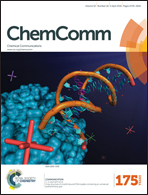Improved chemical and mechanical stability of peptoid nanosheets by photo-crosslinking the hydrophobic core†
Abstract
Peptoid nanosheets can be broadly functionalized for a variety of applications. However, they are susceptible to degradation when exposed to chemical or mechanical stress. To improve their strength, photolabile monomers were introduced in order to crosslink the nanosheet interior. Photo-crosslinking produced a more robust material that can survive sonication, lyophilization, and other biochemical manipulations.

- This article is part of the themed collection: Foldamers

 Please wait while we load your content...
Please wait while we load your content...